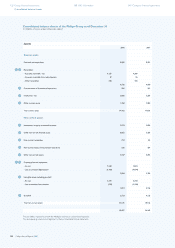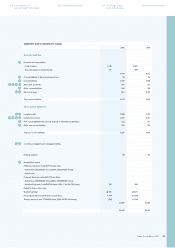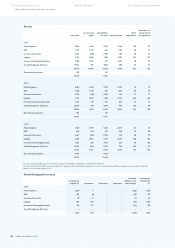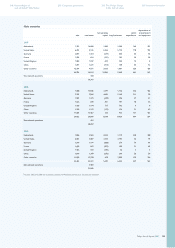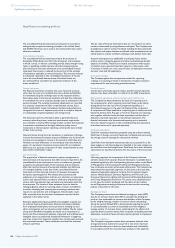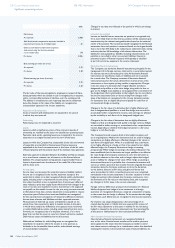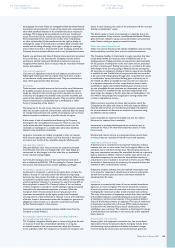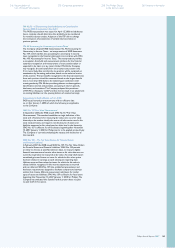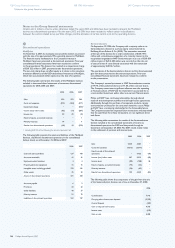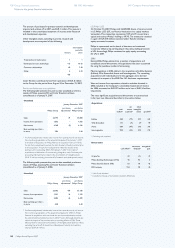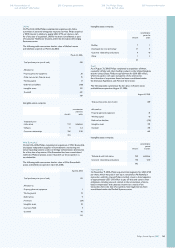Philips 2007 Annual Report Download - page 134
Download and view the complete annual report
Please find page 134 of the 2007 Philips annual report below. You can navigate through the pages in the report by either clicking on the pages listed below, or by using the keyword search tool below to find specific information within the annual report.
Philips Annual Report 2007140
Signicant accounting policies
The consolidated nancial statements are prepared in accordance
with generally accepted accounting principles in the United States
(US GAAP). Historical cost is used as the measurement basis unless
otherwise indicated.
Consolidation principles
The consolidated nancial statements include the accounts of
Koninklijke Philips Electronics N.V. (‘the Company’) and all entities
in which a direct or indirect controlling interest exists through voting
rights or qualifying variable interests. All intercompany balances
and transactions have been eliminated in the consolidated nancial
statements. Net income is reduced by the portion of the earnings
of subsidiaries applicable to minority interests. The minority interests
are disclosed separately in the consolidated statements of income
and in the consolidated balance sheets. Unrealized losses are
also eliminated but considered an impairment indicator of the
assets transferred.
Foreign currencies
The nancial statements of entities that use a functional currency
other than the euro, are translated into euros. Assets and liabilities
are translated using the exchange rates on the respective balance
sheet dates. Items in the income statement and cash ow statement
are translated into euros using the average rates of exchange for the
periods involved. The resulting translation adjustments are recorded
as a separate component of other comprehensive income (loss)
within stockholders’ equity. Cumulative translation adjustments are
recognized as income or expense upon partial or complete disposal
or substantially complete liquidation of a foreign entity.
The functional currency of foreign entities is generally the local
currency, unless the primary economic environment requires the
use of another currency. When foreign entities conduct their business
in economies considered to be highly inationary, they record
transactions in the Company’s reporting currency (the euro) instead
of their local currency.
Gains and losses arising from the translation or settlement of foreign-
currency-denominated monetary assets and liabilities into the functional
currency are recognized in income in the period in which they arise.
However, currency differences on intercompany loans that have the
nature of a permanent investment are accounted for as translation
differences as a separate component of other comprehensive income
(loss) within stockholders’ equity.
Use of estimates
The preparation of nancial statements requires management to
make estimates and assumptions that affect amounts reported in the
consolidated nancial statements in order to conform to generally
accepted accounting principles. These estimates and assumptions
affect the reported amounts of assets and liabilities, the disclosure
of contingent liabilities at the date of the consolidated nancial
statements, and the reported amounts of revenues and expenses
during the reporting period. We evaluate these estimates and
judgments on an ongoing basis and base our estimates on experience,
current and expected future conditions, third-party evaluations and
various other assumptions that we believe are reasonable under the
circumstances. The results of these estimates form the basis for
making judgments about the carrying values of assets and liabilities
as well as identifying and assessing the accounting treatment with
respect to commitments and contingencies. Actual results could
differ materially from the estimate. Assumptions used are further
explained in the related notes.
Estimates signicantly impact goodwill and intangibles acquired, tax
on activities disposed, impairments, nancial instruments, liabilities
from employee benet plans, various provisions including tax and
other contingencies such as asbestos product liability. The fair values
of acquired identiable intangibles are based on an assessment of
future cash ows. Impairment analyses of goodwill and indenite-lived
intangible assets are performed annually and whenever a triggering
event has occurred to determine whether the carrying value exceeds
the recoverable amount. These calculations are based on estimates
of future cash ows.
The fair value of nancial instruments that are not traded in an active
market is determined by using valuation techniques. The Company uses
its judgment to select a variety of methods including the discounted cash
ow method and option valuation models and make assumptions that are
mainly based on market conditions existing at each balance sheet date.
Actuarial assumptions are established to anticipate future events
and are used in calculating pension and other postretirement benet
expense and liability. These factors include assumptions with respect
to interest rates, expected investment returns on plan assets, rates
of increase in health care costs, rates of future compensation increases,
turnover rates, and life expectancy.
Accounting changes
The Company applies the retrospective method for reporting
a change in accounting principle in the absence of explicit transition
requirements for new accounting pronouncements.
Reclassications
Certain items previously reported under specic nancial statement
captions have been reclassied to conform to the 2007 presentation.
Discontinued operations and non-current assets held for sale
The Company has determined that the level of a reporting unit is
the component for which operations and cash ows can be clearly
distinguished from the rest of the Company and qualies as a
discontinued operation in the event of disposal of the component.
A component of Philips qualied as a reporting unit is usually one level
below the division level. Any gain or loss from disposal of a reporting
unit, together with the results of these operations until the date of
disposal, is reported separately as discontinued operations. The
nancial information of a discontinued reporting unit is excluded
from the respective captions in the consolidated nancial statements
and related notes and is reported separately.
Cash ow statements
Cash ow statements have been prepared using the indirect method.
Cash ows in foreign currencies have been translated into euros using
the average rates of exchange for the periods involved.
Cash ows from derivative instruments that are accounted for as fair
value hedges or cash ow hedges are classied in the same category as
the cash ows from the hedged items. Cash ows from other derivative
instruments are classied consistent with the nature of the instrument.
Segments
Operating segments are components of the Company’s business
activities about which separate nancial information is available that is
evaluated regularly by the chief operating decision-maker or the Board
of Management of the Company. The Board of Management decides
how to allocate resources and assesses performance. The Company has
determined that reportable segments are the same as the operating
segments. Reportable segments comprise the Company’s business
sectors: Medical Systems, Domestic Appliances and Personal Care,
Consumer Electronics, Lighting and Innovation & Emerging Businesses,
and Group Management & Services. The sectors are organized based
on the type of products produced and the nature of the markets
served. Segment accounting policies are the same as the accounting
policies as described in this note.
Earnings per share
The Company presents basic and diluted earnings per share (EPS)
data for its common shares. Basic EPS is calculated by dividing the
prot or loss attributable to common shareholders of the Company
by the weighted average number of common shares outstanding
during the period. Diluted EPS is determined by adjusting the prot
or loss attributable to common shareholders and the weighted
average number of common shares outstanding for the effects of all
potential dilutive common shares, which comprise convertible personnel
debentures, restricted shares and share options granted to employees.
Revenue recognition
The Company recognizes revenue when persuasive evidence of an
arrangement exists, delivery has occurred or the service has been
provided, the sales price is xed or determinable, and collectibility
is reasonably assured. For consumer-type products in the segments
128 Group nancial statements
Signicant accounting policies
188 IFRS information 240 Company nancial statements




